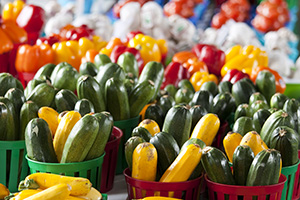
Increase Your Market’s Success with Succession Planting
June 10, 2020 | By Rupp Seeds

Which roadside market would you stop at? One with only 3 or 4 items? Or one featuring a wide range of different fruits & vegetables? Most consumers will stop at the stand that is overflowing with variety, knowing they have a better chance of finding the fixings they need for supper. By using succession planting, you’ll maximize your harvest and have a continuous supply of fresh vegetables all season long.
What is Succession Planting?
There are a few types of succession planting.
- Plant the same crop (i.e., sweet corn) at several times throughout the season to ensure a steady supply of fresh produce.
- Plant the same crop using multiple varieties with different maturities. With this method, you plant once, but harvest each variety as they mature individually.
- Use the same soil (growing area) and plant a second crop after the first one is harvested. In some growing regions, you may even be able to grow a 3rd crop on the same piece of ground.
To plan for succession planting, first start with the crops you would like to grow. Then determine which varieties you are interested in and their days to harvest. You will also need to know the length of your growing season. Additionally, you’ll want to factor in how much produce you sell per day to estimate how much and how often to plant.
There are several factors including cold and heat tolerance, and disease tolerance that can determine whether a variety should be planted early, middle, or late in the season. This is where Rupp’s knowledge can take the guess work out of which varieties to plant and when. We have extensive trials that look specifically at traits and disease protections. Growers can then concentrate on harvesting & marketing a bountiful offering for their valued customers.
Staggering Planting Times
A well thought out crop calendar for seeding, cropping, and harvest is essential for growers using succession planting in their operation. This calendar will be the basis for ordering the right amount of seed and other inputs for the entire season, as well as a quick reference guide to follow for field preparation, labor, and harvesting. This calendar will be especially vital when your time is in high demand. A great time to do this is during the off season while you are browsing through your new copy of the Rupp Vegetable Seed Catalog, reviewing the great new items available to add to your line up.
Setting up a calendar is simple, and each grower can tailor it to meet their specific operation.
- Figure out how much of a certain vegetable you can market within a 2 to 3 week period and how much room it will take to grow it.
- Break your planting beds / fields into three or four sections to grow your 2 to 3 week supply of the crop.
- At the start of the planting season, plant the first bed; wait about 2 weeks and plant the second bed, and then plant the third bed about 2 weeks later.
- When you finish harvesting the first bed, the second bed will be ready to harvest. Note that there will likely be some fluctuation in maturation times due to accumulation of growing degree days. Record keeping is essential where growers can look back on their records from previous years can determine the right amount of time between plantings to ensure a consistent supply.
The length of your planting season determines how many successive plantings you can make. Enter your zip code on this website to find the last spring frost date, the first fall frost date, and the length of the growing season in your area.
Share the space
Another way to use succession planting is to replace a crop that’s finished producing with another one in the same place. For example, after your harvest spinach in the spring, plant cucumbers for the summer, and then after the cukes are harvested, plant kale for the fall. With this method, you can grow a wider variety of vegetables in a small space. Just make sure you’re planting a cool-season veggie for spring or fall and a warm-season veggie for summer.
The following table lists some good succession planting combinations to try. Select one veggie from each season to plant in succession.
Use the same piece of ground in different seasons for different crops.
Spring: Spinach, Mesclun greens, Peas, Radish
Summer: Bush Beans, Cucumber, Sweet Corn, Eggplant
Fall: Kale, Lettuce, Collards, Chinese Cabbage
Some crops may need to be transplanted as young plants from sowings made earlier on to ensure they reach harvesting stage before the season ends. These include many of the cabbage family plants such as kale, cauliflower, and cabbage, plus Florence (bulbing) fennel, beets and lettuce. Some will be harvested in the fall, while others will give a small crop in winter before the main harvest in spring.
The crops you can grow from seed during a second crop: chard, oriental vegetables such as bok choy, herbs like parsley and cilantro, and salad greens such as endive, spinach, and arugula.
Succession planting is one way of having a consistent supply of farm fresh products to attract consistent patrons and build a loyal customer base. A little planning and partnering with Rupp’s knowledgeable consultants, growers can take the guess work out of which varieties they should be planting. Once your customers realize the variety of produce that is available from your market, the sales will speak for themselves.